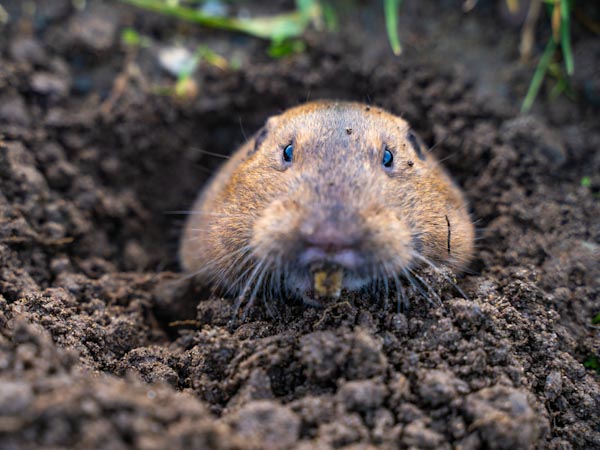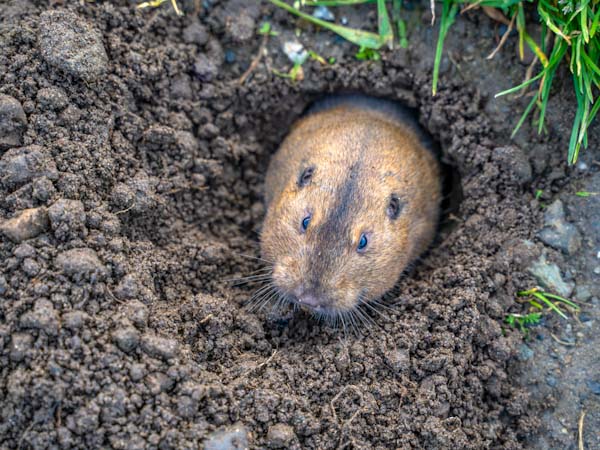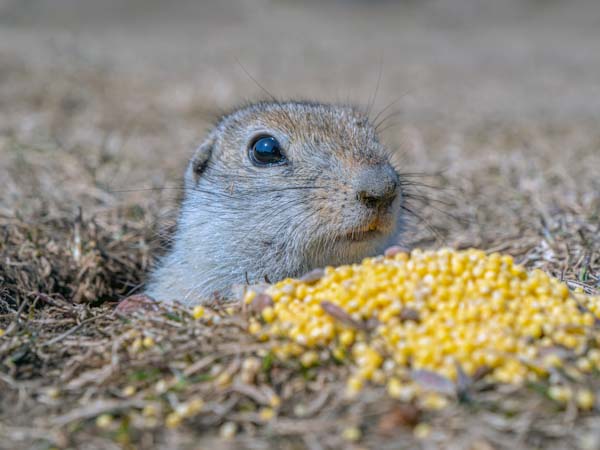Best protection against gopher damage. Highly recommended.
Effective and Reliable Gopher Protection for Your Landscape
Our gopher wire products are specifically designed to provide long-term and dependable subsurface protection against gopher intrusion. Working as an underground barrier, our gopher wire does not harm the gophers but simply keeps them from burrowing into your lawn or planing areas.
Gopher Block® HD
Durable Galvanized Steel Gopher Wire

Gopher Block® UHD
Ultra-Durable Stainless Steel Gopher Wire

Balancing Damage Caused By Pocket Gophers & The Environmental Needs
Studies and research have shown pocket gophers are incredible burrowers when it comes to mounds and tunnels. Their vigorous activities have become an issue with property owners. Gophers have damaged drainage tiles and utility lines, impaired embankments along dikes and ditches, damaged mowing equipment and turned polished lawns and other areas into a total mess.
About Pocket Gophers
These gophers can strip bark off trees and shrubs while making a daily diet out of your commercial and ornamental garden plants from above and underground. So, how can you deal with gophers while still having conservation concerns in Iowa? The state has experienced an incredible loss of grasslands and farm pastures while reducing the number of habitats throughout the state.
Cautions must be shown to control the population of gophers. Reducing their presence on farms should be performed in a way that will not cause economically consequential harm.

Gopher Showing Teeth
Habitats
Plains pocket gophers live in open grassy areas including meadows, prairies, lawns, hay fields, pastures, golf courses, sports fields, and cemeteries. Pocket gophers are likely to set up shop in locations surrounded by grasslands. The presence of ditches, fence rows, field borders, and other grassy areas can enable them to survive within a place that would otherwise be uninhabitable.
Soil composition plays a critical role for gophers to reach their pinnacle of 6 to 8 gophers per acre in areas with porous, well-drained, loamy soil. Areas that have mostly rocky soils have too many problems for burrowing and shallow sandy soils are not strong enough for tunnel walls to remain in place.
As pocket gophers seal their tunnels off from the surface, they must have air to breathe that will circulate through the existing soil. Therefore, soils that are seriously compacted like those loaded with clay or moisture, will not allow enough air to circulate in and out of the tunnel.
These little gophers have small compressed heads along with short, thick necks and muscular forelimbs with long curved claws. This combination makes for a burrowing pro. Their amazing tunnels seem to rule their entire lives from eating, sleeping, and even reproducing.
Plains pocket gophers are solitary animals except when they are breeding or raising their offspring. Plains pocket gophers reach breeding at the age of one After gestation, which is approximately 3 weeks, females give birth, around April to June, to a liter of 3 to 4 pups and in some cases even 10. The males can share the female's burrow for a couple of weeks before moving on to another burrow.
A single gopher can create and take care of their own tunnel system. Therefore multiple systems with multiple gophers can be in a yard or section of a field. Due to their burrowing nature, these gophers spend most of their time underground. They only come to the surface to eat while in close proximity to the tunnel entrances.
After the pups are weaned, the mother and pups will establish a new burrow. While traveling to the new burrow, it can be dangerous while traveling across the surface. Pocket gophers of all ages can fall victim to predators but are especially vulnerable to badgers. Badgers are excellent diggers and are able to get the gophers out of the tunnels.
Leading predators include raccoons, foxes, coyotes, bobcats, domestic dogs, cats, weasels, hawks, and snakes. They can capture gophers in their tunnels easily. All of the above will feed on gophers that head to the surface.

Park with Gopher Problems
A Gopher's Diet
Gophers are herbivores meaning they use their long sharp teeth to gather grass and broad leaves from plants like alfalfa. Gophers are also known to shred the bark of trees and shrubs. When the weather is warmer, gophers will eat bulbs and roots they come across along the way while digging up sections of plants they pull into their tunnels.
There are times they will stretch their body length out of the tunnel to reach neighboring plants to feed on. During colder weather, they will gnaw bark off the trees located on your lawn or in the orchard. During the winter, they often clip off the stems of trees and shrubs.
About Damage Control
In situations where pocket gophers become a serious problem, trapping to remove them is an effective way to cut back on damage.
The best way to prevent gopher damage is to eliminate their point of entry in your landscape. This can be accomplished by installing either galvanized or stainless steel gopher wire under sensitive areas of your landscape such as lawns and planting areas. This is the most humane method and is more of a permanent solutions than the following options.

Coyote with Gopher In Mouth
Trapping
First off, you must find the main tunnel which is normally located 12 to 18 inches away from the plug on the crescent-shaped mound. Once you have located the main tunnel, place traps in the secondary tunnels that run alongside the main tunnel.
To locate the best place to trap or bait gophers, use a metal rod to probe the ground until you find the main tunnel. Again, it's located 12-18 inches from the plug on the crescent-shaped mound. You will know you have found the main tunnel because your probe will not have any resistance from the soil. Place the trap or bait in each direction.
Trapping to get rid of gophers can be a problem in areas that are expansive such as golf courses or fields, but is considered the best approach, especially for smaller places like lawns or embankments.
There are several traps to choose from including:
• Macabee gopher trap
• Death Klutch 1 gopher and mole trap
• Victor Gopher-Getter
• You can read up online to create a homemade trap.
The best time to trap is during the spring and fall months when gophers are at their most active time. Dig out a spot to place the trap then put down two traps facing away from each other in both directions. Sometimes it takes trial and error to set up the best approach. You can leave the tunnel open so the gopher will return to repair the opening. The other approach, repair the opening yourself to prevent the gopher from burying the trap. Either approach will probably depend on the gopher!
You can anchor with stakes and flags so you will know exactly where the traps are located when you return. Check the trap, or traps, every few hours and find a new location for a trap if the first location produces nothing after 48 hours.

Gopher After Climbing From Hole
In Conclusion
Pocket gophers can wreak havoc on lawns, in fields, and any other places they call home. Unfortunately, it's up to people to decide how to treat the problem. Pocket gophers have incredible skills for protecting the environment and the ecosystem. So, how do we treat both sides of the aisle to keep lawns and fields free of these little pests while still allowing them to add important benefits to the soil and surrounding area? There are steps that can be put in place to discourage their living underground on your property. You can read more online to discover other ways of dealing with these gophers. You might be able to keep them away and keep your conscience clear at the same time!



